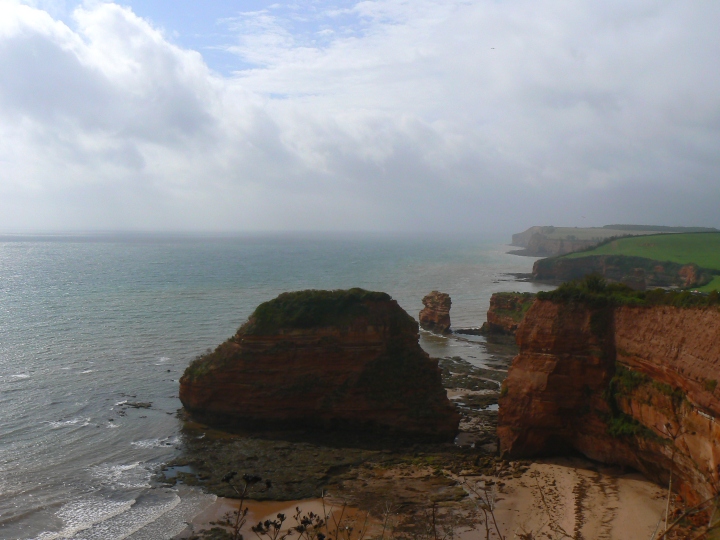
Stacks at Ladram Bay, photo by Mike Goodyer
We had the rare event of eating sandwiches at sea level on the beach rather than at the top of a mountain.
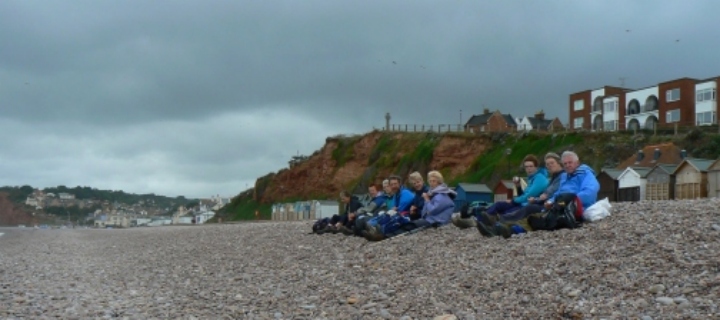
Lunch at sea level, photo by Mike Goodyer
We returned inland. There was some debate as to whether we should stop for a beer as a pub came into view. You can guess at the resolution.
Sunday was a glorious sunny day. We drove east to Eype, walked to West Bay, where magnificent waves where crashing in, then over cliffs to Seatown taking us over Thorncombe Beacon. At Seatown there was another pub argument. We sat in the sun outside the Anchor enjoying the moment before our return inland.
We had two glorious days far from any mountains but the walking up and down cliffs got us puffing. Good company and good food added to the joys of an Autumn ABM Meet.
Report by Belinda Baldwin
September trek – The Freedom Trail -
This years trek took followed one of the hardest wartime escape routes across the central Pyrenees into Northern Spain. Set up in 1994, le Chemin de la Liberte follows much of the original wartime route, and is a fitting reminder to the 30,000 people who escaped along the route and the more than 1,000 people who perished assisting them. The route starts in St.Girons, some 60 miles south of Toulouse, and ends in Esterri d’Aneu, over the Pyrenees, in Spain.
To see Eds photos of the trek click on the image below
It seems traditional that these treks start with rain, and this year was no exception. Exiting the hotel in our waterproofs, we posed for the obligatory group photograph. The route soon winds out of the town and heads up into the woodland that is a feature of this region. Initially a trail goes through close packed woodland, but soon opened out into forest rides, passing several large sink holes on the way. Before long, the weather had changed to a mix of drizzle and mist, so we were able to pack the encumbering waterproofs away. At one part, giant boulders loomed out of the mist in the woods. By midday, we started to come into more open country, with a lovely hamlet where we were able to replenish our water supply.
Never far away from the purpose of the route, the afternoon brought a salutary reminder. Outside one barn was a memorial to a Frenchman who was shot whilst assisting others to escape. Elsewhere there were more joyful reminders of the present, including an old couple who were passionate about restoring an old water mill. At 15 miles, we knew the first day would be long, so it was a relief to reach the auberge at Aunac where we stopped for the night. A great communal meal with the family and other people on holiday, including one person who was touring the region in his red Ford Mustang – now that’s style!
The second day started in woodland, which slowly thinned out to higher pastures. Passing through the hamlet of Esbints, we were surprised to see a street dedicated to John Lennon. By midday we had reached Col de Core, and significant views into the valleys on either side of the pass. There is also a road passing over the col and writing and graffiti on the road identified this as a previous route of the Tour de France. The afternoon saw us out of the woodland and into the high pastures. Our accommodation for the night was the unmanned Cabane de Suberra, one half of which is a bothy, and the other half is lived in by the local shepherd. Whilst our food is spartan, we have the wood fire going, and plenty of brews of tea. We are also joined by two other trekkers doing the route, but are surprised when we hear local East Midlands accents – one of them is from Derby – small world.
The next morning we are treated to a glorious sunrise and we now start to climb significantly. Firstly through high pasture land, where we see a herd of the local black Merens horses. Shortly afterwards, we come across another wartime reminder – the broken and twisted skeleton of a Halifax bomber that crashed just after the war had ended, whilst out on a training flight. A memorial formally identifies and recognises the unfortunate crew.
There’s then a big pull up to the Col de Craberous, at 2,382m. It’s a straightforward ascent, but we all take our time, as the height and weight of our sacks start to make themselves felt. At the col, we are greeted by an equally steep descent which strains the quads, but which then opens up into high moorland and easy walking to another refuge. Passing a lovely clear lake, we start to pull up to the next col, over sets of rock slabs which almost stretch to the horizon. It’s now late afternoon, and we’re all aching from a long day and minimal food over the last 24 hours. As we reach the Col de Pécouch (2,494m), we can finally see our evening’s accommodation at the Refuge de Estagnous. We’re there in little over half an hour, and with the food, beer and hot showers, the body soon starts to recover from the day’s efforts.
We start the fourth day with excitement, as we know we’re crossing into Spain today. To add to it all, we see a flock of seven lammergeyers circling on the thermals. But first, there is the little matter of the immediate route. We descend from the hut into a large cirque, complete with lake and surrounding peaks. At the back of the cirque, a stream rises steeply, at one point breaking into a waterfall over a set of steep slabs. And yes, this is where our route goes. It looks improbable from afar, but when on it, there is a great track up to the level ground above, with occasional wire handrails. Whilst easy enough now, imagine what it must have been like for those people doing the same in civilian clothes at night with snow on the ground, and all the time the threat of capture, or worse, looming over you.
At the end of this part of the ascent, we are greeted by a lovely lake nesting in the hillside, with lovely shades of blues and greens in the morning sun. The pull up to the border is up a steep scree strewn ravine. After a slow haul, we arrive at the Col de la Pale de Clauére (2,522m) and are greeted by our own fly past by a lammergeyer. It’s a long slow descent, firstly to a small tarn, which we stop by for our lunch. Then down again, into the main river valley on the Spanish side, which we then follow unerringly. It’s sparsely populated on the Spanish side, so apart from some herds of cattle and a couple of farmsteads, the valley is fairly deserted. We are now on a forester’s track which we follow for about five miles to where we intend to stop for the night. For some years now, the refuge at Fornet has been shut, something we’ve been aware of before even starting the route, so it’s a bivouac for all of us. We get our shelters rigged and enjoy the small amount of food that we’ve been able to carry with us. My minimalist approach of a sawn off Karrimat and a polythene survival bag to sleep in leave me cold in the night, and I’m greeted by the knowing smiles of those who’ve burdened the extra weight of a sleeping bag for the past few days.
The following morning, it’s a long walk of over ten miles to Esterri d’Aneu, much of it along a minor tarmacked road. We pass some small villages on the way, but at this time of the day, none of them have anywhere open for food. With some relief we make Esterri just after midday, and before long we are sat in the local bar with tapas and beer in hand, somehow managing to converse with the locals. A delightful little village and a great place to end our trek at.
Participants: Ed Bramley, Andy Burton, Steve Caulton, Steve Creasey, Mike O’Dwyer, Myles O’Reilly, Marian Parsons, Mike Parsons, Marcus Tierney. Report by Ed Bramley
AILEFROIDE CAMPING MEET, 16 - 30 July
Mike Pinney has prepared a pictorial account of an ascent of the Barre des Ecrins.
FIESCH HOTEL MEET, UPPER VALAIS, 1st – 16th July
This year’s summer meet was once again based at the Hotel Park in Fiesch in the Upper Goms valley. Rolf and Rosemarie Frei were delighted to welcome us back and we were looked after as hospitably as we were in 2007, with the same delicious meals in the hotel garden.
The weather was perfect on the weekend we arrived, and I spent an unforgettable birthday climbing the Eggerhorn from Ernen in glorious sunshine with panoramic views of the peaks of the Bernese Oberland. There were myriads of edelweiss and small purple asters at the summit, and slopes of flowering alpine rhododendron covering the slopes on our descent into the Rappetal. Alasdair had even organized a surprise birthday party for me back at the hotel, with champagne in the garden followed by a delicious cake, complete with candles, made by Belinda Baldwin.
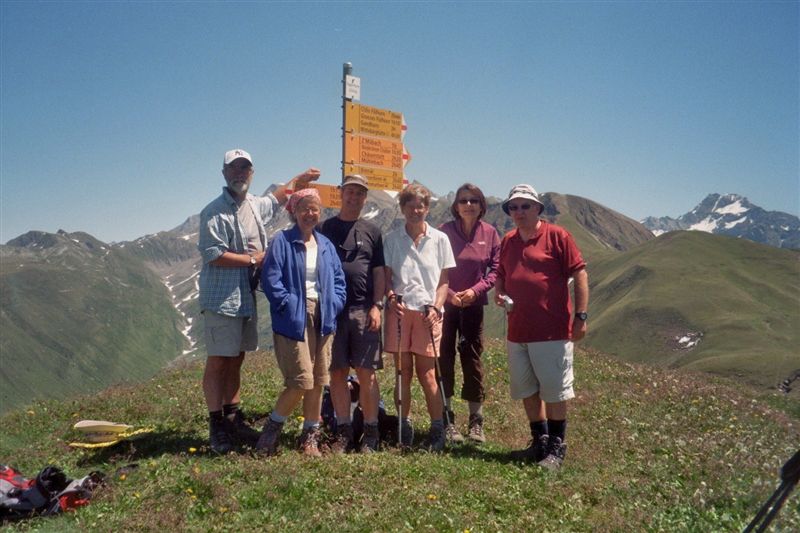
Eggerhorn on 3rd July
Everyone made the most of that glorious weekend, most using the cable car up the Eggishorn to get as high as possible. As the week progressed this cable car was made frequent use of for a variety of walks from Fiescheralp: to the Märjelensee at the edge of the glacier, along to Bettmeralp, Moosfluh and the Bettmerhorn, and to Riederfurka and Villa Cassel, all giving splendid views of the Matterhorn and Pennine Alps as well as across to the peaks of the Oberland. From Belalp some of us walked up to the Tyndall Memorial, erected in memory of John Tyndall, Victorian scientist and mountaineer of the Golden Age who was an honorary citizen of the nearby commune as well as an honorary member of the SAC and the AC, while others made the long steep descent down to the new Hängebrucke suspension bridge high above the glacier, linking Belalp to Riederalp.
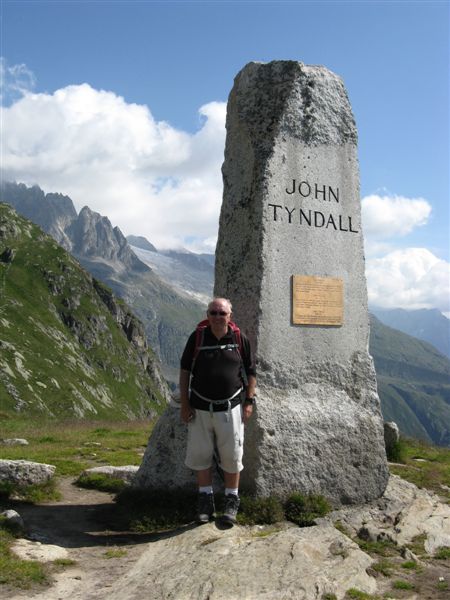
Tyndall Memorial and Alasdair
Several excursions were made into the Binntal, up to the Binntal Hut, more steeply up to the Mittlenbärg Hut, and following the Mineral Tour to the Mässersee. New destinations were discovered, up the Risihorn from Bellwald, and the Folluhorn from Rosswald, both giving panoramic views of the surrounding peaks. There were plenty of lower walks too, into the Fieschertal, along the Gommer High path, and to the lovely village of Ernen with its ancient church and painted houses.
Those of us with cars were able to explore further afield, and the Sidelhorn from the Grimsel Pass, the Brudelhorn from the Nufenen Pass and the Monte Leone Hut from the Simplon Pass were favourite choices, as was the Lotschental, setting of many of Harry Archer’s meets. When the weather was less good we resorted to sightseeing, visiting a variety of places: Locarno and Lake Maggiore, Andermatt and Disentis, Interlaken and the Reichenbach Falls, and the Monet Exhibition at Martigny.
Mark Davison and Tony Arkley as usual aspired to higher things and managed to climb a 3000 metre peak on every day of the first week, even on the day that Tony flew in to Zurich Airport. These included the Klein Furkahorn and Sidelenhorn from the Furka Pass, the Wasenhorn above the Monte Leone hut from the Simplon Pass, and the Piz Gallina and Blinnenhorn from the Nufenen Pass, at 3374 metres their highest summit. All necessitated long days and, keeping to their record, more than one late dinner. Once Mark departed Tony was left to his own devices and set off to cross the Aletsch glacier and attempt the Rothorn. High on the ridge he was caught in a storm and decided to beat a hasty retreat, staying on the same side of the glacier. The long walk out took most of the night, and we were relieved to see him back at the hotel for breakfast the following morning.
The flowers were as spectacular as in 2007, and on our walks we saw edelweiss, alpine rhododendrons, gentians, campanulas, martagon and paradise lilies, and many more, including the rare ‘King of the Alps’. The far-sighted spotted ibex, golden eagles and a grouse family with chicks, while the Fosters had the record for the number of marmots seen, as many as ten on more than one walk.
We have to thank Alasdair for once again organizing a highly successful meet in a beautiful area. However, there are sad memories too for Bill Parish who collapsed while walking down from Fiescheralp on the first weekend and was helicoptered to Sion hospital; he died two days later without regaining consciousness. And this is likely to be Alasdair’s last meet for soon after our return he fell ill and was diagnosed with pancreatic cancer. His meets have taken us to so many different areas over the years, giving us so much enjoyment. Whenever we are in the mountains, we shall remember him.
Participants: Alasdair & Pamela Andrews, Tony Arkley, James & Belinda Baldwin, Antonia Barlen & Bill Parish, Geoff & Janet Bone, Derek Buckley & Ann Alari, Sheila Coates, Mark Davison, John Dempster & Dinah Nichols, John & Marj Foster, Peter Goodwin & Ursula Woodhouse, John Monks, Dick & Lin Murton, Roger Newson, Myles O’Reilly, Mike Scarr, Terry Shaw, Jim & Margaret Strachen, Tony Welling, Elizabeth Wells, Bill & Rosie Westermeyer, Dick & Karen Yorke.
Report by Pamela Andrews
Derbyshire Meet - 29 April to 2 May -
This was a joint AC/ABMSAC meet over the double Bank Holiday weekend. In total there were 13 attendees, 2 got a better offer of going to Nepal (Steve and Natasha) otherwise it would have been fifteen. A good start for an old destination revisited. Myles had never been to Derbyshire before (?!!).
Weather was mainly very sunny with a strong cool north-easterly breeze. Cool at night. Pub and Bunk barn provided good clean basic accommodation and washing facilities and good food on Saturday night which everyone seemed to enjoy.
Ed, Marcus and Andy met up at the pub at 1pm Friday and went to Aldery cliff for a pleasant afternoon on this now well gardened BMC owned Limestone cliff with crag side parking.
They climbed did Ash Tee Slab (HS), Clothesline (S) and Surface Plate (HVS), some in better style than others!
On the Saturday Laura Millichamp (AC) and partner Mark went over to the Roaches and had a good day out there.
Myles, Heather, Dick Murton and Lyn cycled against strong head winds along the High Peak and Tissington trails and Mike O'Dwyer did his own thing on a mountain bike, the one the burglars did not steal.
Mike Pinney, Ed, Marcus, Gemma Hagen (AC) and climbing partner Julian, and Andy went to Froggatt, where all the favourite routes were climbed, Sunset Crack/Sunset Slab, Green Gut, Allen's Slab, Heather Wall.
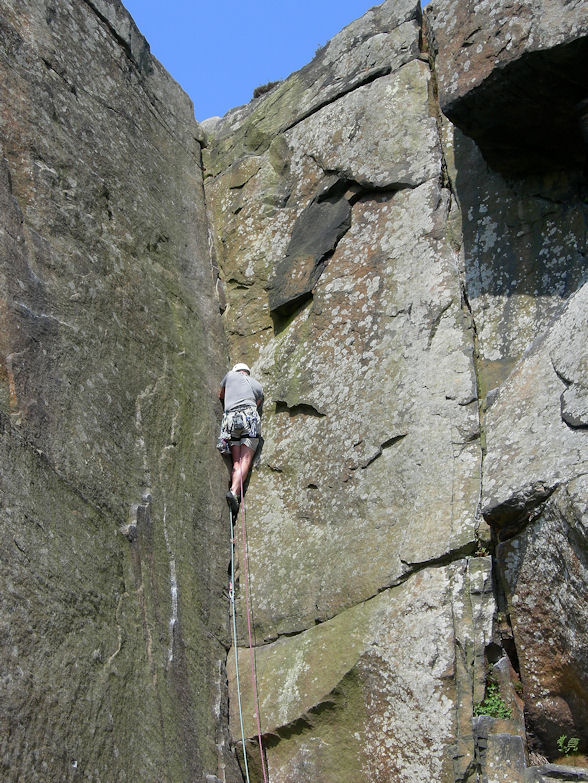
Ed leading Green Gut, Froggatt Edge. Photo by Mike Pinney
Julian led Tody's Wall and Three Pebble Slab onsight and Marcus and Mike P Pedestal Crack (HVS) to the right of Green Gut in the sun, not bad for two 50 year olds. Ed talked in the bar the previous evening of doing 20 routes but only managed nine, I guess he meant everyone's total together!! Still a beautiful day especially for the dedicated seconds (Strong cool breeze at the top of the Edge).
Sunday saw Laura/Mark/Gemma and Julian make for Willersley and Matlock Bath areas for some limestone climbing. Mark and Gemma did Lobo and Sphynx both VS on Wildcat.
Myles, Heather, Ed, Marcus, Mike P and Andy did the walk from Earl Sterndale over Parkhouse and Chrome Hill finishing off at the Quiet Woman for a pint in the sun.
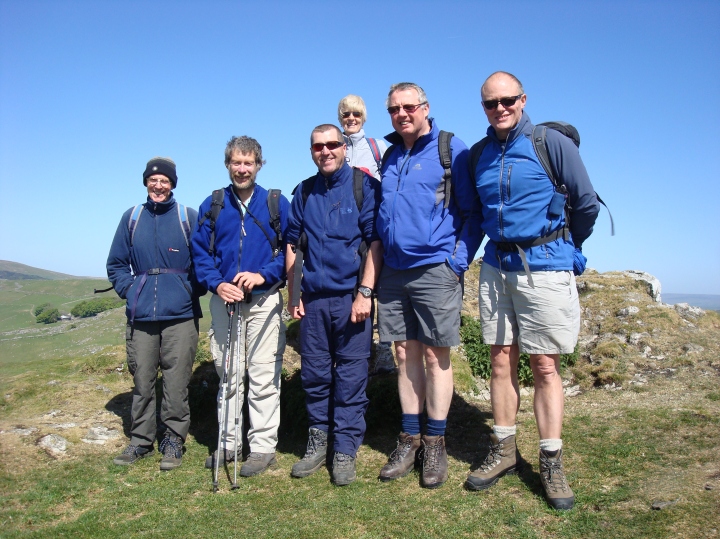
The team on Chrome Hill. Photo by Heather Eddowes
Mike P and Marcus had to forego the pint in the Quiet Woman as they went to Aldery Cliff and climbed Nettlerash (HS) and Carmen (VS) before it got too cold. Everybody else returned to the Royal Oak and pitched the tent, outer only, for the evenings BBQ. Then the team prepared for the evenings entertainment. The BBQ lasted until it was cold enough to warrant going into the pub.
Monday saw Mike O'Dwyer gone at 6-30am for some more serious off roading. Heather followed Mike, only about 3 hours behind.
Mike P., Ed, Marcus and Andy went to Gardoms Edge where activity was confined to the Apple Buttress area. Mike P and Marcus climbed NMC crack (HVD), Flake crack (HS), Apple Buttress (VS) and Velve Cracks (VS). Andy and Ed did Apple crack (VD) and NMC crack, but unfortunately Andy put his shoulder out and that terminated their day.
Myles having newly discovered the Peak District set off home. We hope to repeat this meet next spring.
Report by Andy Burton.
Further photos are on the photos page.
THE KINGDOM of the THUNDER DRAGON - Bhutan Meet, 14th - 30th April 2011
A year or so after our 2007 trek in the Everest region of Nepal some of us started talking about another Himalayan meet, but something less strenuous, at a lower altitude, and with more comfortable accommodation. Bhutan seemed the ideal choice as it has spectacular mountain scenery and a fascinating Buddhist culture, yet is still unspoilt and little visited. Rather than using a UK agency we decided to deal directly with a Bhutanese tour operator as this would give us the opportunity to individualise our programme. Boonserm Tours, run by Tashi Namgay and his elder brother, had been personally recommended, and Tashi arranged a customised itinerary with a short three day camping trek to get closer to the mountains and comfortable hotels for the other nights from where we could do a variety of day hikes.
Once in Bhutan we soon appreciated how lucky we were to have found Tashi and his company. Everything had been efficiently organised well in advance, and nothing was too much trouble for him: we were even accompanied throughout by a cameraman making a DVD of us and our trip. His knowledge and enthusiasm for his country and its culture were evident, and we all agreed that his leadership was a major factor in our enjoyment of the trip.
The short flight from Kathmandu was spectacular as we flew along the chain of the highest Himalayan peaks past Everest and Lhotse, then Makalu and Kanchenjunga – though we had to wait for the return flight to get window seats on the right side of the plane - and spiralled down into the Paro valley to land at the tiny airstrip.
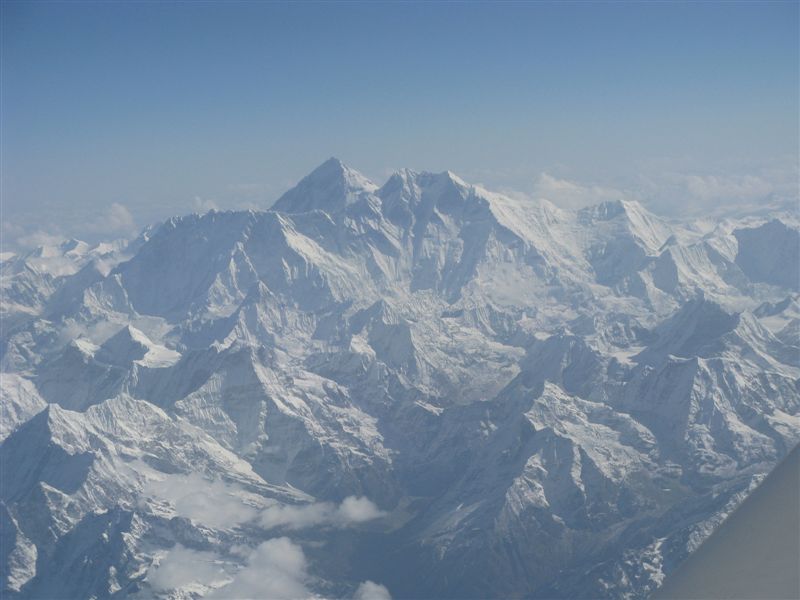
Everest, Lhotse and Nuptse from the plane to Paro
As we walked out of the plane we realised at once what a special country this was: the airport building looked like a brightly painted medieval palace, and in the distance we could see the first of the many fortress-like dzongs we were to visit and the watchtower on the hill above it. Ours was the only plane, and it was all very quiet and peaceful, even more so in contrast to the noisy, crowded streets we had just left in Kathmandu. Our hotel was nearby, also beautifully painted and decorated, with large rooms, modern en-suite facilities and splendid views.
As we walked around Paro we soon got used to seeing the Bhutanese, including the schoolchildren, in traditional dress, part of the country’s policy to preserve its cultural heritage. For men this is a gho, a knee length robe belted at the waist with large white detachable cuffs, and for women a kira, a long skirt with a short jacket, elegant and often brightly patterned. For formal occasions, including visits to dzongs, a scarf has to be draped over the shoulder in a special way – not easy to arrange, nor to keep in place.
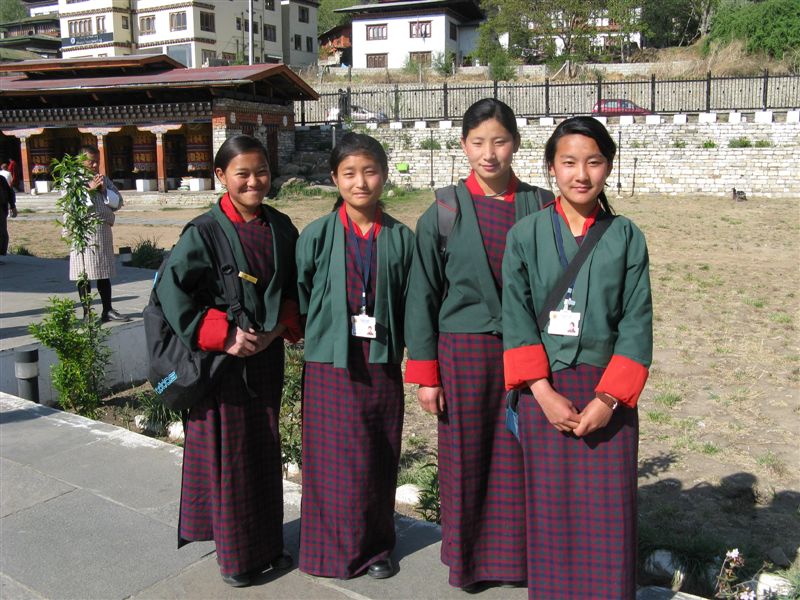
Schoolgirls in national dress
We called in at the weekly open-air market first where the local produce was displayed on the ground: hard chunks of yak cheese and the many vegetables we were to taste in all our meals, including curly fern fronds and the ubiquitous chillies which, together with red rice, form the basis of the Bhutanese diet. Nearby an archery contest was taking place, the participants in brightly coloured ghos. Archery is the national sport, and though taken very seriously is great entertainment. Powerful metal bows fired arrows at an amazing speed towards a small target 150 metres away, yet the target was frequently hit; when one team did miss, their opponents delightedly mocked them with a derisory song and dance.
We set out the following day for ‘Tiger’s Nest’ Monastery, perhaps Bhutan’s most famous site, clinging to the side of a sheer cliff high above us in a dramatic location. The trail was steep and dusty through a forest of red rhododendrons, and we were occasionally overtaken by those less active than ourselves riding ponies. As we passed prayer-wheels and many brightly coloured prayer-flags, it became increasingly evident how integral a part of everyday life Buddhism is. All Bhutanese monasteries are beautifully carved and painted outside, with statues of Buddha and even more splendid paintings within, and this was no exception. Tashi explained how the Guru Rinpoche had flown here from Tibet on the back of a tigress to subdue a local demon and bring Buddhism to the valley, hence the monastery’s name.
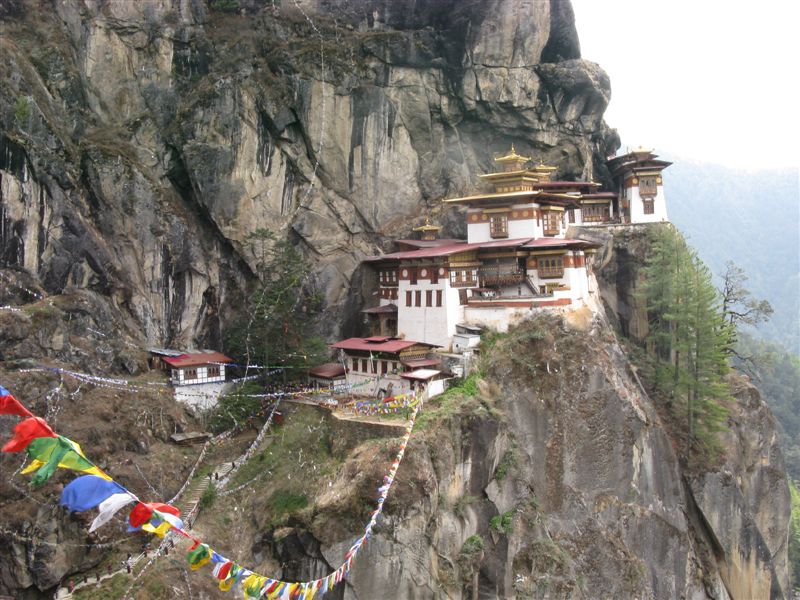
Tiger's Nest Monastery
On our return to the valley we visited the ruined fort guarding its entrance, and were invited into a local farmhouse nearby to see the hot-stone baths in the outhouse, and for drinks of butter tea and ara, the local firewater. A few bowls of this helped us to get to know each other, and we soon became a most harmonious group, most of us past retirement age. With some resident in the UK and others in the Nyon region of Switzerland, there was always someone different to talk to and something different to talk about.
The following morning we visited the National Museum in the old Ta Dzong watch tower, then the huge Rinpung Dzong, once a fortress but now an administrative and monastic centre, again with beautiful carvings. After lunch we started on our trek into the unspoilt Haa valley, part of the ancient trade route to the Chumbi Valley in Tibet and not opened to tourists until 2004. We met no other trekkers in the three days we were there, a welcome contrast to the crowded trails of Nepal. The ponies had left earlier with our gear, and we arrived after a gentle two hour walk to find the tents already up, including a large dining tent with tables and chairs. We were quickly served tea and biscuits, and bottles of whisky and brandy were produced later before a delicious dinner. The following morning we were brought ‘bed tea’ and a bowl of warm washing water before an al fresco breakfast.
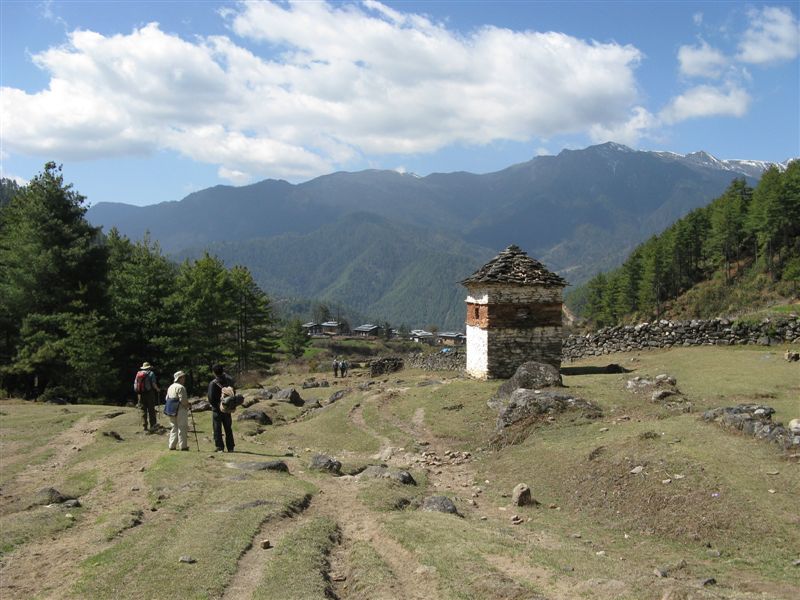
Trekking into the Haa Valley
The hardest day was the next with a steep ascent of over 800 metres through rhododendron forest to the Saga La at 3725 metres, with prayer flags blowing in the strong wind and views of the distant high peaks. Then it was downhill to a picnic lunch and our next campsite, an idyllic spot carpeted with sheets of purple primula denticulata, with a baby yak and its mother grazing nearby. It quickly grew colder as this was 3350 metres, and that night the temperature dropped to -4°C and the ground the next morning was covered in frost. But we soon warmed up once the sun rose, and as we ate breakfast we were rewarded with clear views of the snow-capped peaks across the valley. It was a gentle trek downhill past more primulas, white rhododendrons tinged with pink and sweet smelling daphne, with our other guide Karma at hand to identify the flowers and birds for us. We wandered through small villages, past women working in the fields in their long kiras and a family building a house in the traditional way, with rammed earth walls and carved wooden frames and windows. Once it was finished the house would be decorated with paintings of animals, flowers, or even a large phallus, part of the cult of the ‘divine madman’ to ward off evil spirits.
That afternoon we drove to the capital Thimphu for a two night stay in another splendid hotel, and then for a further two nights at the old capital of Punakha, its beautifully situated dzong at the confluence of two rivers. Our days consisted of a variety of walks, some steeply uphill to a brightly painted temple or monastery high on a ridge, others through terraced fields of rice and wheat, with oxen ploughing as in medieval times. The flowers were always lovely, with huge rhododendron, magnolia, and poinsettia trees all in flower, and tiny primulas and gentians at the side of the trail.
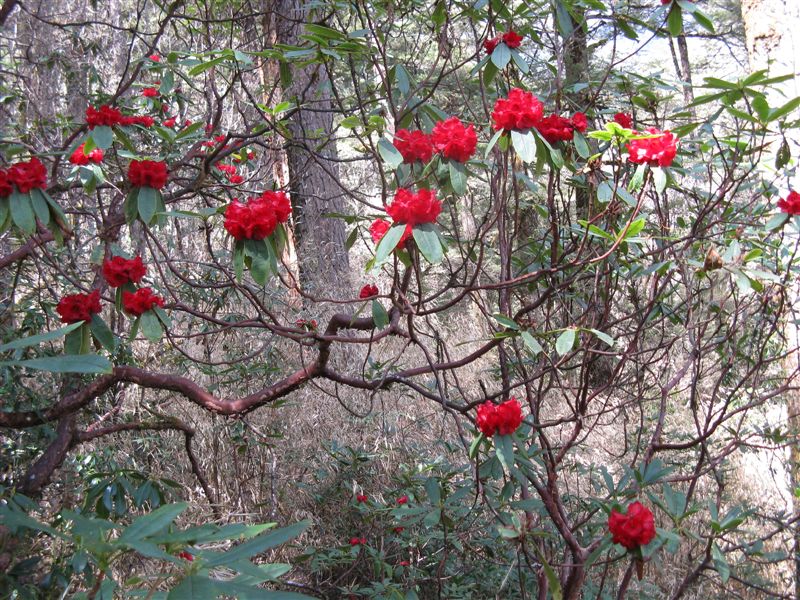 Rhododendron
Rhododendron
We visited many spectacular dzongs, learned to walk clockwise round all Buddhist monuments, heard the fable of the Four Friends, listened to boy monks practising musical instruments, marvelled at the 108 stupas at the Dochu La, and saw the strangely shaped takin, the national animal of Bhutan. We were all impressed by our visit to the Choki Traditional Art School, started by Tashi’s father and now directed by his sister Sonam. Here economically disadvantaged students were given the chance to learn the traditional skills of painting, carving, weaving and embroidery which would enable them to earn a good living back in their home villages, and as we toured the various classrooms we could see the progress they made over their years of disciplined training.
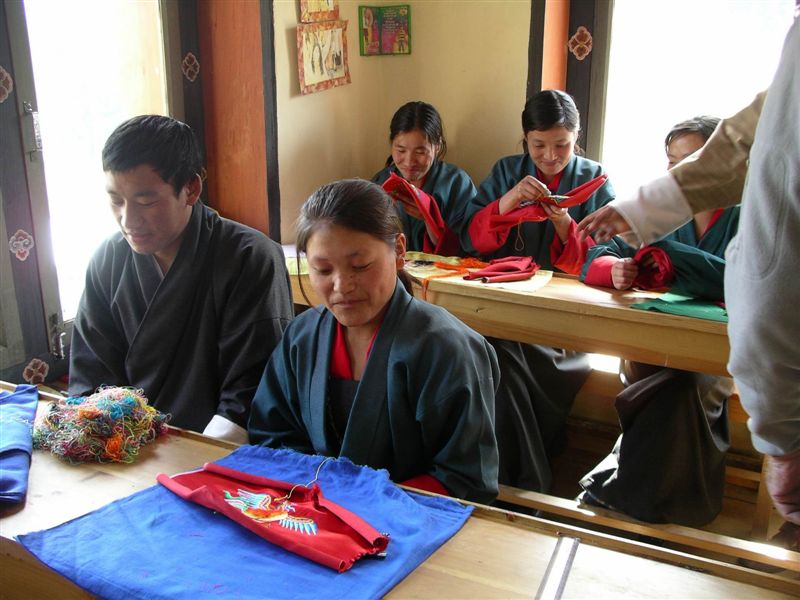 Embroidery class at Choki School
Embroidery class at Choki School
The furthest east we visited was the Phobjikha Valley where our hotel rooms were heated with wood-burning stoves – not easy to keep alight. The valley is renowned for the rare black-necked cranes which spend the winter months here, flying back to Tibet for the summer, and there was great excitement as we hiked along the Nature Trail and spotted the one crane which this year had remained behind. We saw a film about these birds at the Black-Necked Crane Information Centre, and then walked up to the Gangtey monastery which these birds circle three times when they first arrive in the valley every autumn. That afternoon we had our final hike up to the Shashi La at 3480m, with more rhododendrons, prayer flags and yaks on the summit, and more views of the distant peaks.
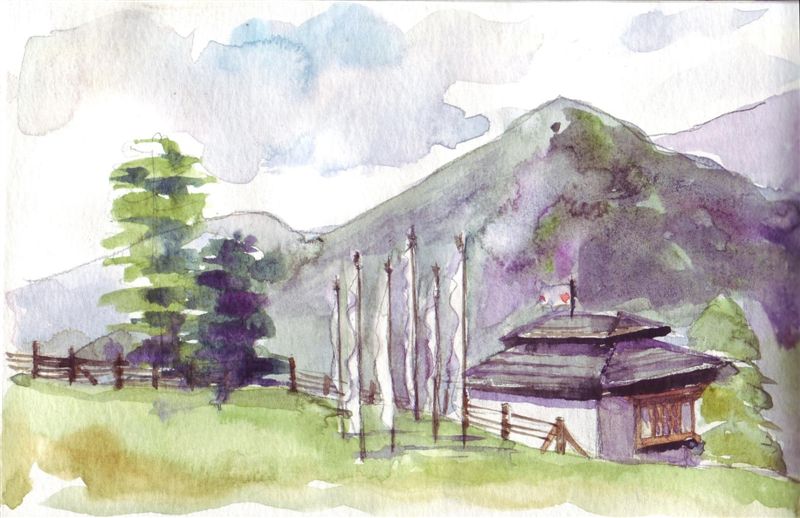 Phobjikha Valley - sketch by Sue Coales
Phobjikha Valley - sketch by Sue Coales
All too soon it was our last day and time for the drive westwards back to Paro. Bhutan is not a large country, about the size of Switzerland, but our drive took several hours as all roads are very slow, being poorly surfaced, narrow and winding , often over high passes; it is said that the longest straight stretch of road in the country is the runway at Paro airport. We were blessed with clear skies for our final drive, and as we crossed the 3350 metre Lawa La we could see the highest snow-capped peaks of Bhutan, including Jhomolhari, sparkling in the distance.
As a farewell Tashi had organised a cultural show for us where we were treated as honoured guests. We were presented with gifts of Bhutan tee-shirts, and sat down with aperitifs to enjoy the generous hospitality of Boonserm Tours and watch the traditional songs and folk dances, and the masked dances normally seen only at religious festivals. The dancers looked magnificent in their brightly coloured costumes, with huge animal or demon headed masks, and as they whirled increasingly faster to the music of horns, drums and cymbals we were caught up in the spell. As the evening drew to a close we appreciated once more how lucky we were to have visited such a special country, with such a special guide. Bhutan is indeed a magical place, a true ‘Shangri-La’.
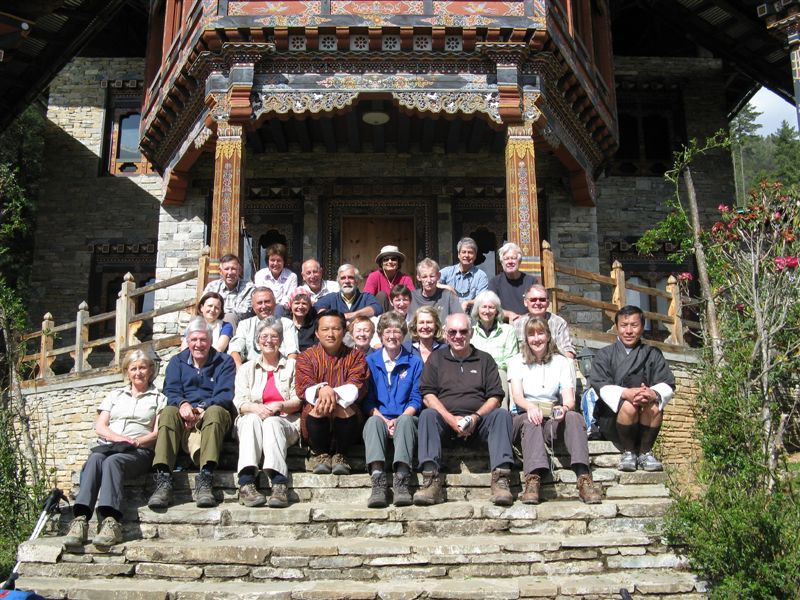 The Group at the Dewachen Hotel - picture by Choki
The Group at the Dewachen Hotel - picture by Choki
Participants: Pamela & Alasdair Andrews, Geoff & Pauline Causey, Susan & Elaine Chapman, Edward & Sue Coales, John Dempster & Dinah Nichols, Niels & Guni Doble, Richard & Katherine Heery, Anne Jago, Horst & Mecky Kroha, Roger Newson, Rick & Carol Saynor, Bill & Rosie Westermeyer.
All uncredited photos and the report by Pamela Harris-Andrews
Further photos are on the photos page.
FOOTNOTE: Commemoration of Alasdair Andrews. Money has been raised to help the Choki school visited on the trek. A plaque has been presented to the Choki Traditional Art School, Bhutan.
Further information is in News.
Braemar Meet Report - 18 - 21 March,
This was a very well attended meet with 19 members booked to attend. Unfortunately Peter Farrington had to drop out at the last minute due to illness, from which we hope he has now recovered.
The Invercauld Hotel was the base for the meet, and once again it proved to be comfortable and good value for money. On the drive up on Friday there was lots of snow on the hills right down to road level and the forecast was reasonable with no precipitation expected over the weekend, although wind was predicted for the summits.
Friday -
Morag MacDonald and Ian Brebner decided to ascend the Cairnwell (933m) from the Glenshee car park only to find high winds making walking difficult on the top.
Alasdair and Pam did Mount Blair (744m) from Cray near the Spittal of Glenshee.
Saturday -
Groups headed off for the hills with Morag and Ian heading for the Loch Muick area and reporting that due to deep wet snow conditions they settled for the circumnavigation of Loch Muick; which I understand was hard going. Alasdair and Pam set off up the nearby Corbett, Morrone, (859m) only to get bogged down in wet snow and high winds eventually beating the retreat.
Our group including J & M Strachan, J & M Foster, J Dempster, D Nicholls, P Hands, F & P Semple, J Urmston set off on the three mile walk up to Glen Callater Lodge, from where we contoured along above the loch until we reached the coll, before striking up to the summit of Carn an t-Sagairt Mor (1047m). The snow conditions improved as we gained higher ground, but not sufficiently hard to demand the use of crampons. As the temperature had come up considerably during the day wet snow lower down made the descent unpleasant. The round trip was about 10 miles and we arrived back at the cars about 5.30pm.
James and Belinda decided to attempt the challenge laid down by John Dempster. Knowing that they enjoyed long walks he suggested that they may wish to attempt “Devils Point” (1004m) - starting from the Linn of Dee taking the road to Derry Lodge and then track via the Luibeg Burn to the Corrour Bothy, before climbing the path up the coire, turning south on the ridge to the point. They made a bold attempt, turning back short of the Dee but chalking up approximately 12 miles. Under the prevailing conditions this was quite a feat. Well done James and Belinda, you may wish to set a target for John’s next foray.
P Goodwin & U Woodhouse set of for Glenshee with the intention of doing Carn Aosda (917m). Having attained the summit plateau they were beaten back by high winds, which made progress very difficult.
Sunday -
Ian & Morag headed off looking for the Messiah in Dundee; I trust it was an enjoyable performance.
The large party of yesterday was joined by James, Belinda, Peter and Ursula. After the previous hard day, it was decided to tackle the Corbett “Morrone” (859m).Thanks to Alasdair and Pam’s attempt the previous day we were able to use their tracks to start with. We encountered high winds on the summit, which proved uncomfortable in the extreme, and we sheltered behind a hut which was erected by the Braemar Mountain Rescue Team to commemorate someone who had died from exposure (probably trying to pick the padlock to get in). From the summit we headed south down the track to the old road leading back north to Braemar, and the Fyfe Arms, where we quenched our thirst to the strains of Hampden Roars as the locals were watching the Rangers V Celtic Derby.
Alasdair and Pam did two walks, Craigendarroch to the north of Ballater and Craig Connich 538m just south east of Braemar.
Monday -
Most set off home leaving a few hardy souls to sojourn out against the elements. Fred and Paul Semple drove to the Linn of Dee and walked into the wind towards Glen Tilt, turning beyond the “White Bridge” before driving back to Edinburgh.
J & M Strachan, J Dempster, D Nicholls and P Hands, parked at the Glen Shee car park with the intention of doing the Cairnwell (933m) and going on to Carn a’ Gheoidh (975m). After an ascent up steep snow to just below the summit we encountered very high winds blowing us off our feet, making it very difficult to retrace our steps to the shelter of a cable pulley house. We agreed the tops were definitely not on, so descended beside a piste to the skier’s café for a welcome bowl of soup before departing to the south.
J & M Foster with J & B Baldwin on route to Fort Augustus drove around to Cockbridge, just below The Lecht ski area, and climbed the Corbett behind the ski area – Carn Ealasaid (792m). “Not too much snow, but damned windy”. However, the surprise was the wonderful views from it, particularly of Lochnagar and into the high Cairngorms from an unusual direction. It is a walk that John hopes to repeat, and recommends for future meets.
Report by Jim Strachan
Onich Meet, Inchree Centre - 26 – 28 February
After the downpour at Loch Tay in January, the second Scottish winter meet of 2011 was favoured with far better conditions.
The forecast for Saturday was for bright periods and blustery showers, and it was right. Most of us climbed Meall Dearg (the centre peak on the Aonach Eagach) from the North. Pam and Alasdair visited Ardnamurchan in search of sunnier weather and were able to sunbathe on the summit of Ben Hiant while the rest of us were battling through a snowstorm on the way to our summit.
On Sunday we woke to a fine morning with a covering of fresh snow above about 500m. Margaret, Jim, Roger and I had a bracing day on Stob Coire an Chairn in the Mamores, culminating in a knee wrecking descent to Mamore Lodge. Others opted for more cultural pursuits.
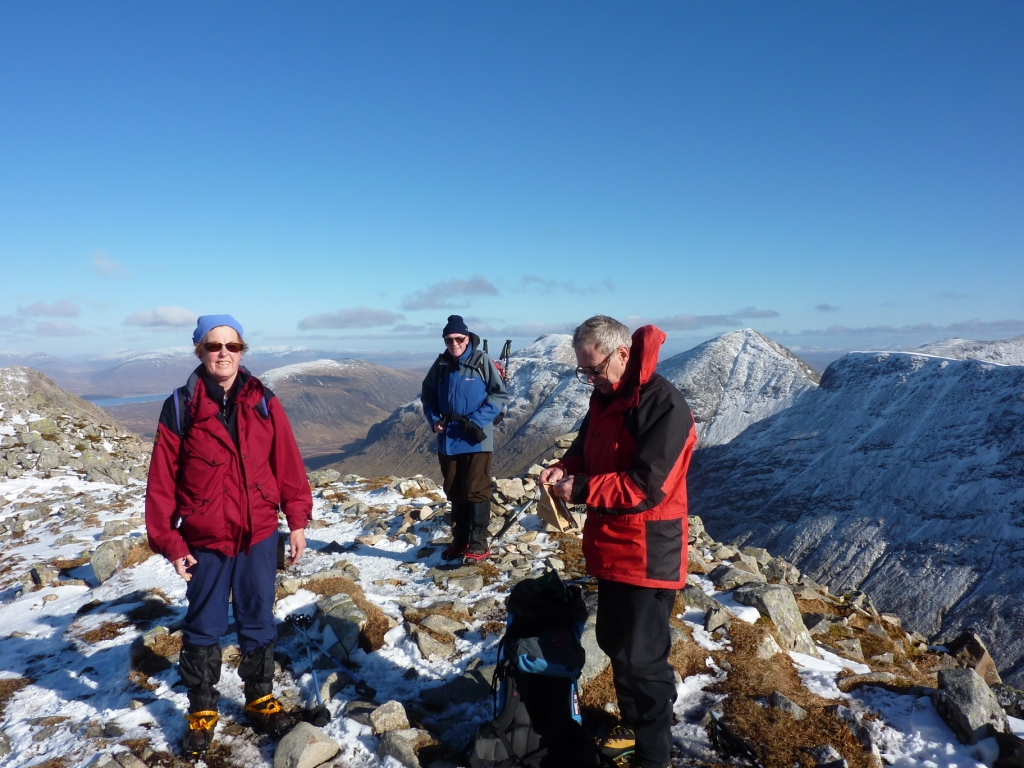
Marg Foster, John Dempster and Roger James (with an incredibly well packaged sandwich) on Stob Dubh. Photo by John Foster
Those of us who stayed for the Monday were rewarded with a cloudless morning and a hard frost. Roger and I had a look at Lagangarbh gully on Buchaille Etive Mor, but decided there was too much fresh snow in it, so we joined Marj and John on Buchaille Etive Beag. Cramponing over some snow patches we duly reached the summit and were rewarded with fabulous views particularly over Bidean, the scene of some previous epics. We then descended by a new engineered path which leads direct from the col to the main road. I could not help wondering if such a path is really necessary but there is no doubt that it made the descent faster and easier than it would otherwise have been.
All in all it was a very successful meet. The Inchree centre was a convenient base but it’s a pity that the cottages were designed for small dwarfs with no gear.
Present: Alasdair and Pam Andrews; John Dempster; Marj and John Foster; Peter Goodwin and Ursula; Roger James; Margaret and Jim Strachan.
Report by John Dempster.
Further photos are on the photos page.

| | | | | | | | | | | 























